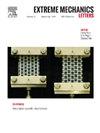Multiscale structure-mechanical property relationship and data-driven design of ultra-high temperature ceramics: A review
IF 4.5
3区 工程技术
Q2 MATERIALS SCIENCE, MULTIDISCIPLINARY
引用次数: 0
Abstract
Ultra-high temperature ceramics (UHTCs) exhibit exceptional melting points, superior oxidation resistance, and outstanding ablation performance, positioning them as indispensable materials for extreme-environment applications. However, their inherent brittleness, high density, limited elasticity, and poor fatigue resistance restrict broader implementation. This review presents a rigorous, multiscale examination of interrelationships between UHTC structural characteristics and mechanical behaviors, addressing critical knowledge gaps in failure mechanisms and state-of-the-art design of strengthening and toughening strategies. The analysis commences with crystal-chemical principles and progresses through salient microstructural and mesostructural characteristics, followed by an exploration of thermally induced deformation and structural evolution at elevated temperatures. The dominated factors in mechanical degradation and corresponding strengthening and toughening mechanisms across nanoscale, microscale, and mesoscale levels are systematically dissected. Furthermore, we highlight recent advances in high-throughput screening within materials genome engineering and the integration of machine learning (ML) for rapid property prediction and structural optimization of UHTCs. Finally, prospective multiscale design strategies are proposed to synergistically optimize the balance of strength and toughness in UHTCs.
超高温陶瓷的多尺度结构-力学性能关系与数据驱动设计综述
超高温陶瓷(UHTCs)具有卓越的熔点,卓越的抗氧化性和出色的烧蚀性能,使其成为极端环境应用中不可或缺的材料。然而,它们固有的脆性、高密度、有限弹性和较差的抗疲劳性限制了它们的广泛应用。本文对UHTC结构特征和力学行为之间的相互关系进行了严格的、多尺度的研究,解决了失效机制和最先进的强化和增韧策略设计方面的关键知识空白。分析从晶体化学原理开始,通过突出的微观结构和细观结构特征进行进展,随后探索高温下的热致变形和结构演变。在纳米尺度、微尺度和中尺度水平上系统剖析了机械降解的主要因素和相应的强化和增韧机制。此外,我们强调了材料基因组工程中高通量筛选的最新进展,以及机器学习(ML)的集成,用于UHTCs的快速性能预测和结构优化。最后,提出了未来的多尺度设计策略,以协同优化UHTCs的强度和韧性平衡。
本文章由计算机程序翻译,如有差异,请以英文原文为准。
求助全文
约1分钟内获得全文
求助全文
来源期刊

Extreme Mechanics Letters
Engineering-Mechanics of Materials
CiteScore
9.20
自引率
4.30%
发文量
179
审稿时长
45 days
期刊介绍:
Extreme Mechanics Letters (EML) enables rapid communication of research that highlights the role of mechanics in multi-disciplinary areas across materials science, physics, chemistry, biology, medicine and engineering. Emphasis is on the impact, depth and originality of new concepts, methods and observations at the forefront of applied sciences.
 求助内容:
求助内容: 应助结果提醒方式:
应助结果提醒方式:


